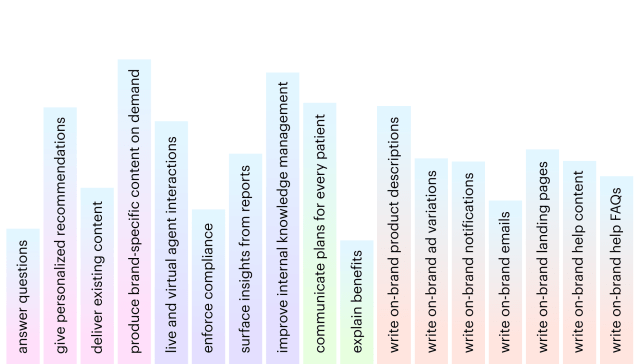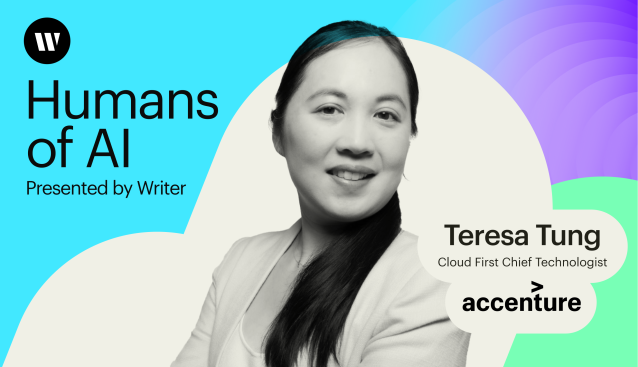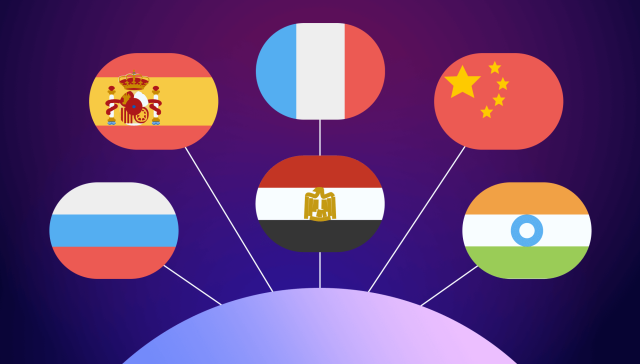AI agents at work
– 10 min read
Everywhere at once: Optimizing the CPG digital shelf with generative AI

If the first iteration of digital transformation in consumer packaged goods (CPG) was the move to online shopping, the second round might best be described as “everything, everywhere, all at once.” The buyer experience encompasses speed, multiple channels, and personalization — all while facing stiff competition.
You have to optimize every element of your digital shelves across various retailers while simultaneously promoting your products across the entire online ecosystem. All while constantly adapting to shifting buyer expectations and loyalties.
Everything, everywhere, all at once, indeed.
Meanwhile, according to the 2024 Consumer Products Industry Outlook report from Deloitte, the substantial price increases over the past few years may have hit a ceiling: consumers are unwilling to pay more. The new path to profitability is through a strategic blend of increased sales volume and a more profitable product mix.
Of course, any increase in volume puts pressure on the digital shelf. CPG brands may find that they need to sell in more retail channels — a significant burden when trying to manage the digital shelf across dozens, or even hundreds, of retailers.
Generative AI reduces these pressures at CPG companies by introducing speed into a manual and tedious process of managing the digital shelf — while also maintaining brand and compliance requirements.
- Generative AI helps CPG companies optimize their digital shelves by quickly creating and updating product detail pages (PDPs) that meet the requirements of different retailers.
- Generative AI can help CPG companies create personalized content at scale, which can lead to higher conversion rates.
- CPG companies can stay ahead of the competition by incorporating SEO keywords and refreshing existing content using generative AI.
- Generative AI allows CPG companies to bring products to the digital shelf faster and maintain brand consistency, enforce compliance, and optimize for conversion — all in a fraction of the time.
The digital shelf: a challenge for CPG companies
As direct-to-consumer (DTC) companies have emerged, they’ve used speed to their advantage. Their direct access to customer purchase data allows them to react quickly to trends. They’re formidable competitors between their products and tactics across digital channels.
Many legacy CPG companies are still playing catch-up to these digitally-native counterparts. It’s a tall order since DTC companies are narrowly focused and have control over the channel experience. Yet CPG companies still wield the power of brand loyalty … if they can stay in front of their customers. A flashy DTC campaign on social media might not be enough to lure consumers to try a new deodorant or toothpaste if their favorite brand remains front and center on their favorite channels.
CPG companies have to attract audiences in the same way as DTC companies — through a strong online buyer experience tailored to audience demographics — across all of the channels where their products are sold. Compelling ad campaigns and aggressive SEO can beat DTC brands by drawing in repeat purchases rather than losing business because customers are curious about the competition.
However, the appeal of increased volume is caught in a content bottleneck. You’re facing unique product detail page (PDP) requirements from each retailer, plus varying strategies for algorithms. Every time a writer reworks a PDP to meet the specified word count, sections, compliance requirements, and other granular details, there’s a cost factor and a time factor.
Optimizing each element of the digital shelf, from product details to images to SEO, is a monumental task. Even if you develop a good process for optimizing new products, hundreds of existing products don’t receive the same level of attention. Meanwhile, the digital shelf constantly evolves as technology and consumer behavior change.
How generative AI helps CPG companies win on the digital shelf
“Profitable volume” may seem like an oxymoron, especially when increased volume comes with an exponential need for additional resources. Crafting content to rise to the challenges of the digital shelf is a task that’s both laborious and unending.
While it’s true that the need for content will continue to increase, generative AI eases the burden of content creation for CPG companies.
Using generative AI, companies can meet the volume demands of the digital shelf. Generative AI rapidly produces content for every channel, leading to faster time to market and less money spent on internal writers, contractors, or agencies. It could take a human writer hours or days to write PDPs for each online site. Generative AI does the same in minutes. Hours saved on PDP creation frees up human writers for more creative ad work or social media campaigns to better compete with DTC brands.
Digital shelf creation is only the first step. Awareness comes from social channels, ads, and search engine optimization — all of which need content that’s highly tailored to the target audience. Generative AI helps companies create high-quality content at every stage of the customer lifecycle.

Digital shelf creation and maintenance
Even though your products are spread across many eCommerce sites, you must provide a consistent shopping experience, no matter where the buyer engages with your products. In fact, Mastercard lists consistency across digital shopping channels as one of the top consumer goods industry trends. The need to “create a coherent omnichannel shopping experience [is] paramount.” That’s tricky when your digital shelf extends across many retailers.
With a full-stack generative AI platform like WRITER, you can launch and maintain products on your digital shelf. With custom apps designed for your business, you can:
- Keep your brand consistent
- Meet compliance requirements
- Easily create product pages
Our customers have seen an average of 50–70% faster time to live for their digital shelves.
You can quickly and easily update your digital shelf in response to emerging trends, ensuring your products remain relevant and attractive to customers. Your digital shelf shouldn’t lose sales volume simply because your content team doesn’t have time to make updates. According to our internal data, it takes 20–60% less effort to maintain the digital shelf using generative AI.
All your efforts to drive customers to your digital shelves depend on a split-second action: when that customer clicks “Add to Cart.” While generative AI supports many content use cases for CPG companies, the digital shelf is a clear focal point.
Product detail pages
Creating PDPs for every product is a two-pronged task. You have to meet the retailer’s requirements and give your product the best presence, so it has the highest likelihood of converting. Optimized PDPs will lead to a higher sales volume, yet editing a PDP for each retailer is time-consuming at best and a never-ending mountain to climb at worst.
Generative AI reduces the resources needed to manually create PDPs for each retailer. With WRITER, users input product information and a custom AI app automatically generates variations for each retailer. Each PDP meets the retailer’s specifications like the number of words, sections needed, the audience, and the voice/tone of the channel.
With inputs like the product’s properties, examples of well-performing PDPs, and WRITER APIs, users can generate retailer-specific variations of PDPs in a few clicks. When you add a new retailer, you can easily modify your custom app in WRITER to output a new PDP format: a one-time setup process that saves time with every future output.
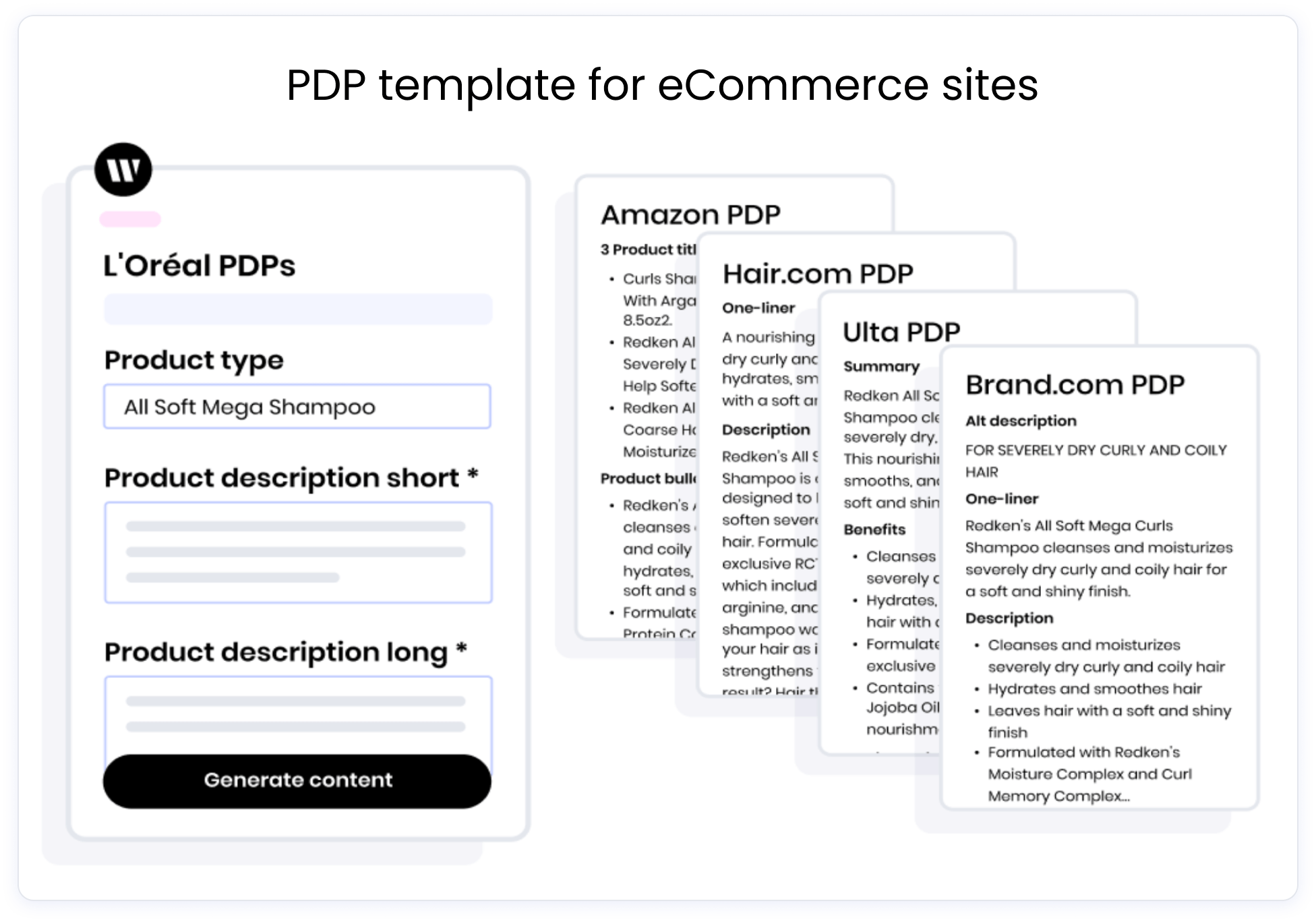
A leading beauty products company developed a suite of custom apps and optimized PDPs in WRITER to enhance its digital presence across various eCommerce platforms.
After implementing WRITER, the beauty product company saw a 29% increase in Amazon traffic for a flagship brand. They report a savings of about 55,000 human hours per year generating PDPs.
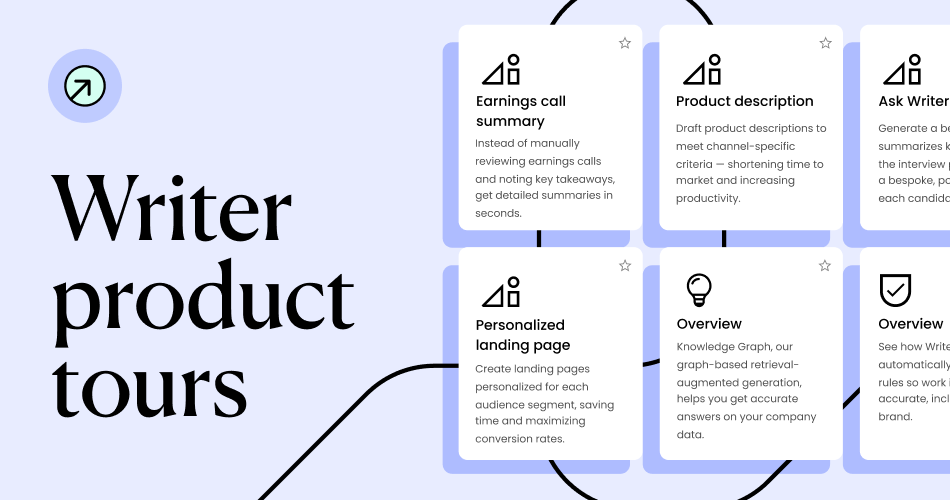
See WRITER in action:
take a tour of a PDP generation app
Brand, ESG, and regulatory compliance
On top of information about the product, each description should align with brand guidelines and voice. No matter where your customers shop, the experience should be the same across all products and platforms.
In WRITER, you can set up approved terms and a style guide to ensure that your PDPs are written with specific brand terminology. A CPG company with 36 global brands and four divisions uses WRITER for dozens of its brands to stay in compliance with vendor requirements.
You may also need to meet regulatory requirements, particularly if you sell in different countries. Each country’s laws will dictate what you can and can’t include in your descriptions and messaging. With WRITER, you can modify PDPs for different regulatory requirements, as well as translate content into 30 different languages. Your writers don’t have to be experts in regulatory requirements; instead, they can rely on generative AI for compliant output.
Many CPG and retail companies have made environmental, social, and governance (ESG) considerations part of their strategic initiatives. Adore Me (acquired by Victoria’s Secret) has focused on sustainability, which impacts the language the company uses in its product descriptions. “It is trying to find a balance between communicating what is better about specific materials, fibers, and processes, but doing it in a way that’s not talking down to a customer, that’s still very accessible,” says Ranjan Roy, SVP of Strategy at Adore Me.
Roy describes the company as “strict” about the terms it can use. Adore Me built an entire style guide in WRITER, specific to sustainability language. “ESG is a strategic push for us and the reason the style guide is even more relevant,” adds Roy.
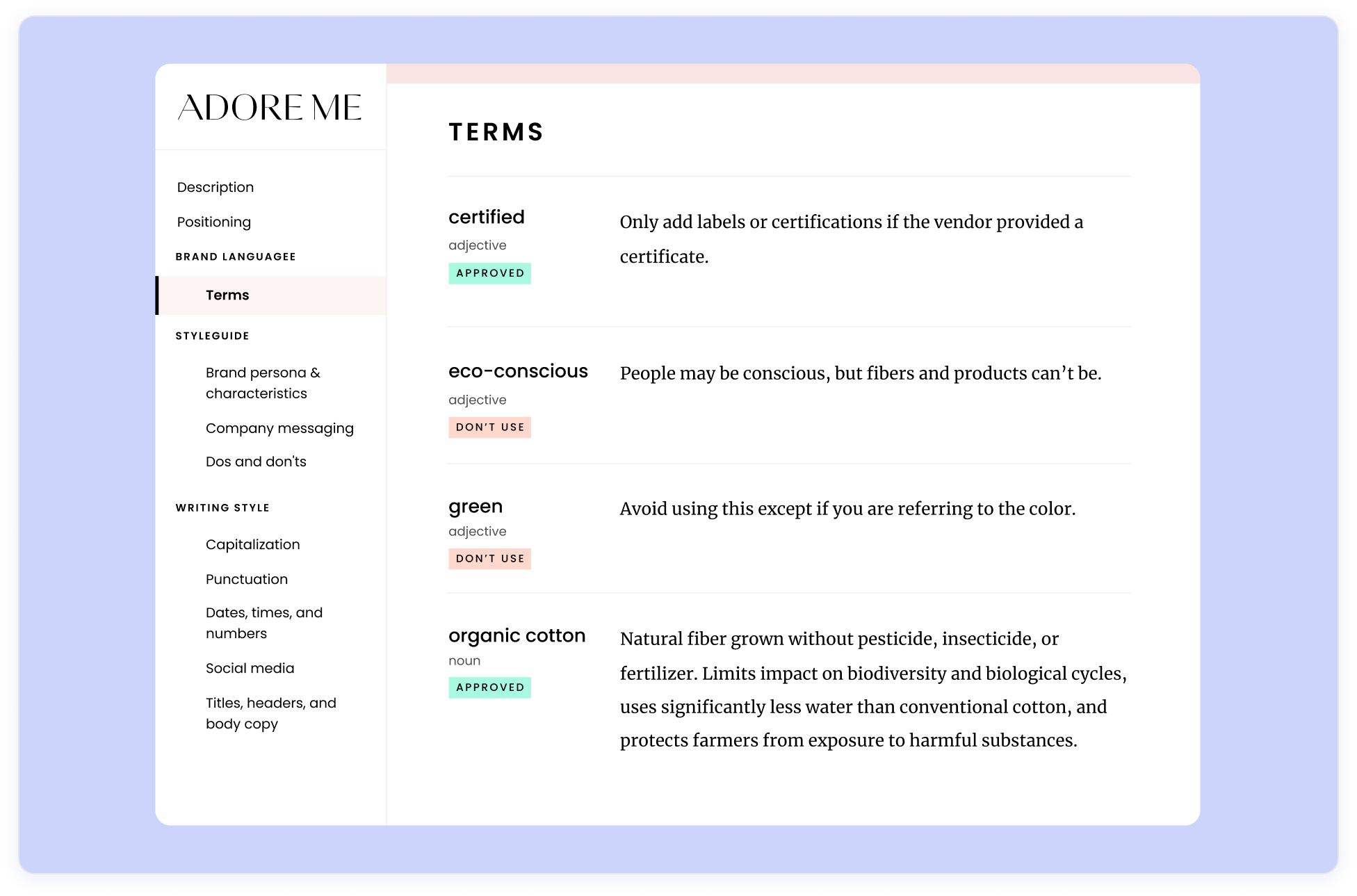
If your company is starting a new ESG or rebranding initiative, WRITER can update all existing PDPs with new messaging. This type of change can take months of legwork across thousands of assets. With WRITER, the same transformation can take place in a few hours.
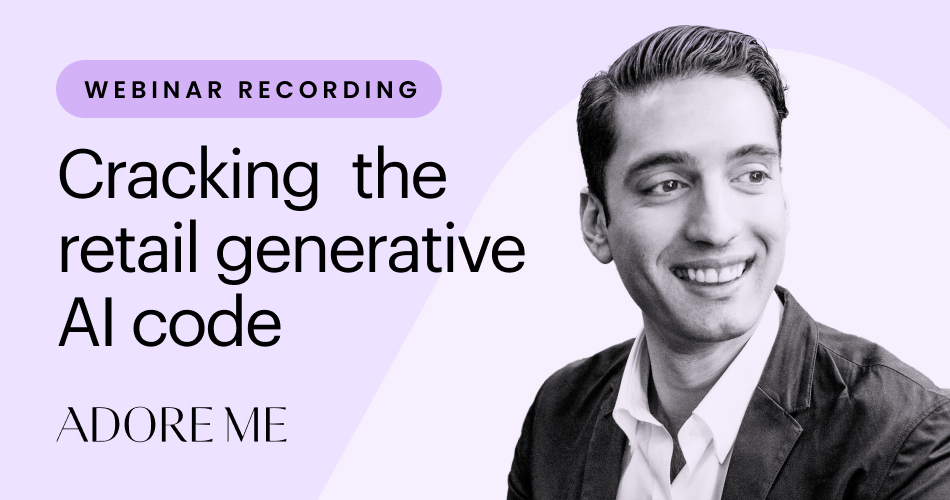
Learn more about Adore Me’s generative AI journey:
Check out our webinar
Ad and product image compliance
While you want your product packaging and campaign images to make your product look its best, you may face some of the same regulatory restrictions as your product descriptions.
A globally-recognized pet care brand faces these challenges with regulations in different countries. In the past, the brand paid a third-party agency to build detailed PowerPoints outlining the requirements for each market. An internal team had to check each image against the appropriate PowerPoint for compliance. This painstaking, manual process can add weeks to regulatory approval timelines, slowing down product and ad campaign launches.
With generative AI equipped with a vision model, the pet care brand team can now automatically enforce regional rules.
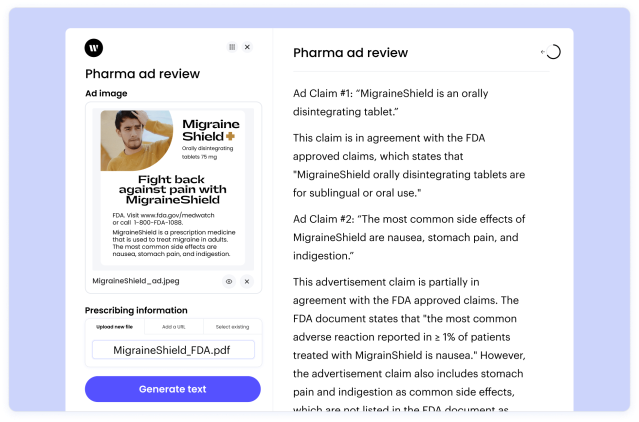
All they have to do is upload an image file and the WRITER image analyzer app will evaluate if the image adheres to regional regulatory requirements and will recommend changes where necessary. What took weeks can now take hours.
Speed and volume with generative AI become a CPG brand’s competitive edge
CPG companies must adopt the same agility as their DTC competitors, even while operating under a different business model. Traditional tactics of listing products and advertising alone won’t compete.
But CPG brands have a distinct advantage: presence in both the physical and digital worlds. Brand loyalty exists wherever your customers are shopping, and you can reinforce that loyalty with your content.
Generative AI allows CPG companies to bring products to the digital shelf faster. It’s built for volume and speed, allowing you to increase your output without cutting into your profitability. You’ll no longer be bogged down by volume. Instead of a never-ending backlog of content updates, you can maintain brand consistency, enforce compliance, and optimize for conversion — in a fraction of the time.
Check out a product tour of WRITER apps built for retail and CPG use cases.

